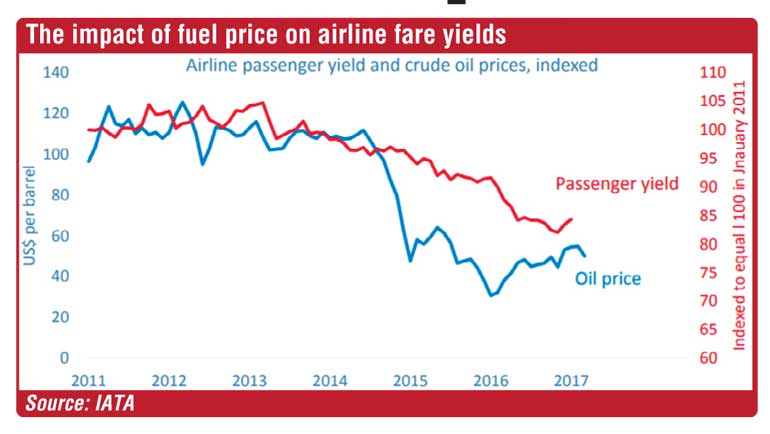Wednesday Mar 12, 2025
Wednesday Mar 12, 2025
Thursday, 28 December 2017 00:00 - - {{hitsCtrl.values.hits}}

The management of SriLankan Airlines has sent the following response to the article titled “The ‘lost two years’ of SriLankan Airlines” published in the Daily FT yesterday.
The author infers that “fuel costs are the only market variable costs that any management has no control over”, and assumes that the true efficiency of the company’s performance can be easily measured by eliminating the fuel cost volatility. However, by making the sweeping statement, the author has ignored several key variables – which results in a significantly misleading representation. Among these are:
The revenue mix: As data from IATA demonstrates (see chart), airline fares are inextricably linked to the market fuel price – with lower fuel prices resulting in lower fares due to market dynamics. However, in adjusting only one of the variables (fuel price), the author ignores the impact the other linked variable directly exerts on the airline’s performance.
The author also ignores the increases in supplier costs, such as airport fees and reservation costs, as well as aircraft leases – where the rate increases are often built-in to the agreements signed earlier with limited possibility to change. Even though fuel costs may decrease, these other costs remain as per legacy agreements entered into by the previous management.
Currency volatility: It is also worth noting that the majority of an airline’s payments to suppliers, which are international in nature, are US Dollar-denominated – that have seen significant cost increases in 2016 and 2017 due to the depreciation of the Sri Lanka Rupee. The author has glaringly omitted the movement of these key variables in reverse-applying the current fuel price to prior years, thereby creating a misleading representation of the results.
Finally, the statement “revenue loss due to the airport closure by the present management” (emphasis added) shows a further misrepresentation of the facts. The much-needed daytime runway closure for three months which was beyond the airline’s control, resulted in an estimated net loss of $ 30 million. That alone would have led to a profit as the author’s own figures show.
Click to read Sanjana Fernando's original article: The “lost two years” of SriLankan Airlines
Click to read Sanjana Fernando's response to this article: SriLankan Airlines’ Six Million Dollar Man
Discover Kapruka, the leading online shopping platform in Sri Lanka, where you can conveniently send Gifts and Flowers to your loved ones for any event including Valentine ’s Day. Explore a wide range of popular Shopping Categories on Kapruka, including Toys, Groceries, Electronics, Birthday Cakes, Fruits, Chocolates, Flower Bouquets, Clothing, Watches, Lingerie, Gift Sets and Jewellery. Also if you’re interested in selling with Kapruka, Partner Central by Kapruka is the best solution to start with. Moreover, through Kapruka Global Shop, you can also enjoy the convenience of purchasing products from renowned platforms like Amazon and eBay and have them delivered to Sri Lanka.
Discover Kapruka, the leading online shopping platform in Sri Lanka, where you can conveniently send Gifts and Flowers to your loved ones for any event including Valentine ’s Day. Explore a wide range of popular Shopping Categories on Kapruka, including Toys, Groceries, Electronics, Birthday Cakes, Fruits, Chocolates, Flower Bouquets, Clothing, Watches, Lingerie, Gift Sets and Jewellery. Also if you’re interested in selling with Kapruka, Partner Central by Kapruka is the best solution to start with. Moreover, through Kapruka Global Shop, you can also enjoy the convenience of purchasing products from renowned platforms like Amazon and eBay and have them delivered to Sri Lanka.